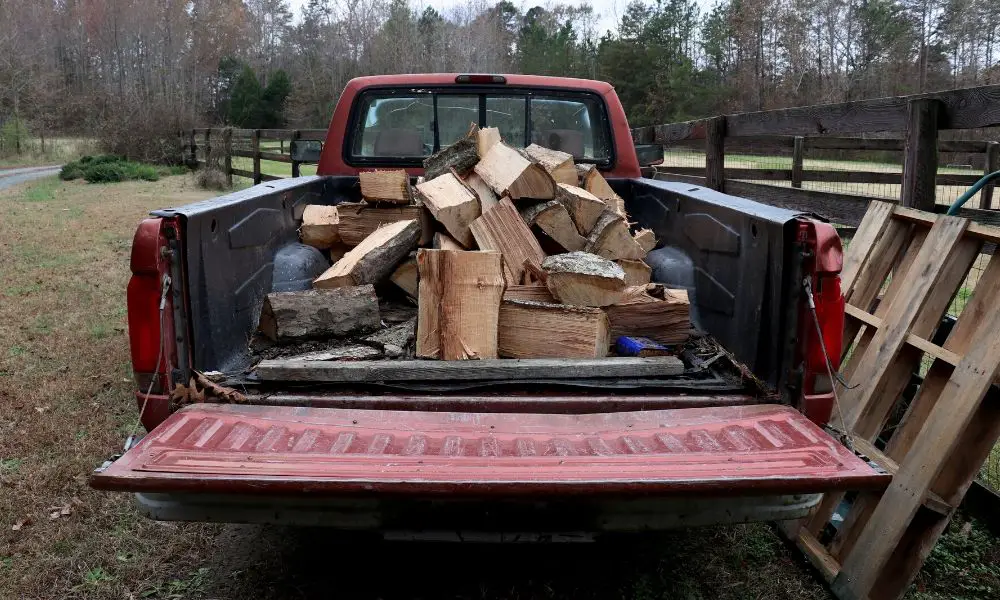We may get commissions for purchases made through links in this post. Thanks for the support! 👍
Knowing your truck’s bed size will help you find out what kind of trailers you can tow, how many supplies you can store, and more. However, you likely won’t find your truck’s bed size labeled inside the bed. The good news is that it’s very easy to calculate its dimensions without heading to the dealership.
To find out your truck bed size, measure the length and the width in inches, then divide the number by twelve. Use the answer (which will now be in feet rather than inches) to multiply the length by the width. This will give you the truck’s square footage and storage space.
Throughout this post, I’ll explain how you can quickly determine your truck’s length, width, and square footage. I’ll also provide a handful of other ways to get the job done if you don’t have measuring tape, yardsticks, or rulers.
1. Measure the Truck Bed’s Length
Quickly find a measuring tape at least 10 feet (3 m) long. While most truck beds aren’t this long, it’s better to be safe than sorry. You can also use yardsticks or rulers, though you’ll have to mark each length to ensure you don’t overlap or underlap (this error could lead to massive mistakes with your measurements).
Keep these tips in mind when measuring your truck bed’s length:
- Always measure the interior portion of the truck bed since that’s where items will be stored.
- Make sure you account for toolboxes, rail protectors, and other installments that could reduce the truck bed’s length.
- Take the measurements in inches rather than feet (it’s much easier to convert the dimensions later).
2. Check the Truck Bed’s Width
You won’t need as big of a measuring tape to find your truck’s width because they’re rarely wider than five or six feet (1.5 or 1.8 m). Remember, you’re not measuring the tailgate. Most truck tailgates are a few inches narrower than the bed, which can result in incorrect measurements. It’s often best to measure the width of the bed in the center or closer to the cab to avoid mishaps.
Here’s a list of suggestions when finding your truck bed’s width:
- Ignore the wheel wells in your dimensions unless you’re installing a truck bed floor/epoxy.
- Measure the widest part of your truck bed, which includes measuring under the overhanging ledges.
- Use a leveling tool to ensure the measuring tape isn’t angled; otherwise, you’ll add or subtract a couple of inches.
3. Divide and Multiply To Find the Truck Bed Size

It’s always better to start with inches rather than feet. For example, starting with a 5.6-foot (1.7 m) truck bed is much more difficult to convert to inches. After all, 5.6 feet (1.71 m) isn’t 5 and a half feet (1.68 m). It’s actually 67.2 inches (1.71 m). If it were 5.5 feet (1.68 m), it’d be 66 inches (1.68 m).
It is recommended to start with inches and then dividing the total length by 12 and the total width by 12 to get the foot total.
Once you have the total feet, you can multiply them. For example, if you have a 5’ x 7’ truck (1.7 m), it has 35 square feet (3.25 sq m).
Another method is to multiply the measurements before converting them to feet. Using the aforementioned example, a 60” x 84” (1.52 x 2.13 m) truck bed is 5,040” (128 m), which you divide by 12 to get the foot total, then divide by 12 to get the square footage. The total comes out to 35 square feet (3.25 sqm). This route is a bit more complicated, but it’s useful if you forget to do the conversions early.
4. Alternative Solutions To Find Your Truck Bed Size
If you don’t have any measuring tools, there are plenty of other ways to find your truck bed’s dimensions. Some of these methods are much more time-consuming, which is why they’re not the main method I’ve suggested. Nevertheless, they’re good to keep in mind in a pinch.
Try some of these ways to find your truck bed size:
- Get the VIN and contacting an automobile dealer. They can look up your vehicle and find all the specs, including the truck bed size. This is a quick solution, but you’ll need to access the VIN. It’s usually on the lower portion of the windshield or the dashboard.
- Use a search engine to find your truck’s make, model, and year. Make sure you head to the truck manufacturer’s website for accurate information. Remember that many truck models come in multiple sizes, so you’ll need to know the year and whether or not you have a limited edition truck.
- Read the owner’s manual to find the vehicle’s dimensions. If your vehicle has an owner’s manual, you likely won’t need the VIN, measuring tape, or a dealership. Sift through the pages or use the table of contents to find the exterior dimensions, then look for the bed. Some manuals have internal bed dimensions, too (which is even better).
- If you have accessories in your truck bed, you can contact the dealer. For instance, if you have an ARE truck bed, they’ll know the dimensions of your truck bed. These companies have to know the dimensions of your make and model to fit it with a camper shell, trailer, and other accessories.
While it’s not always convenient or possible, you could contact the previous owner. Many vehicle owners keep prior records if something goes wrong with the sale or if they want to get a new version of the same make and model. Make sure they measure the bed’s interior dimensions if you want to know the storage capacity and square footage.
Note: Look for letters next to the model, such as EX or X. These often indicate that the bed is extended or short.
Final Thoughts
The vast majority of trucks have their dimensions listed online or in the owner’s manual. Consider writing the measurements elsewhere if you need the number handy at all times. After all, it affects what you can tow, carry, store, and more.


![18 Ways You Can Make Your Truck More Modern [Best Truck Accessories]](https://amanandhisgear.com/wp-content/uploads/2021/03/Lightbar.jpg)